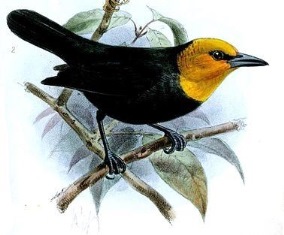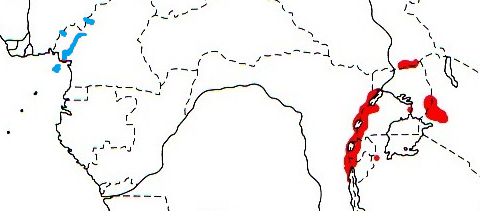Weaver Wednesday [60]: Black-billed Weaver 2013-08-07 (400)
 Weaver Wednesday
Weaver Wednesday

The Black-billed Weaver Ploceus melanogaster is a striking black bird with some yellow on the head and is found in forest undergrowth. The yellow varies according to subspecies and sex: the yellow extends to the throat in the female but the male's throat is black; the male of the nominate race has a yellow collar across the breast. Young birds are variable depending on their age, with dark brown upperparts, and brown to olive or buff below, but they are always identifiable by a yellowish face patch. This is one of 3 spectacled weavers (see also Spectacled Weaver P. ocularis), with a black line running from the bill through the eye. The all-black Vieillot's Black Weaver P. nigerrimus overlaps in range but occurs mainly in the canopy.
The Black-billed Weaver is found in 2 widely separated populations which form 2 subspecies (see map below, based on Birds of Africa):
P. m. melanogaster in eastern Nigeria, Cameroon and on Bioko Island (see blue on map). The male of this subspecies has a yellow collar separating the black chin from the rest of the black underparts.

P. m. stephanophorus, in eastern DRCongo and East Africa (see blue on map). The male of this subspecies has black underparts and a yellow face.
The Black-billed Weaver inhabits undergrowth and dense secondary bush at 540-2440 m (mainly l000-2200 m) in montane forest. There is one record in a Eucalyptus plantation. There may be seasonal altitudinal movements. It generally keeps low in dense foliage, and sometimes comes to the ground, where it moves by hopping. It is usually found in pairs, but at times 5-6 birds may be together. The Black-billed Weaver sometimes joins mixed-species flocks.
Its diet is insects, including ants, beetles, termite alates, cicadas and caterpillars. It also feeds on fruits and seeds and once on a small frog. The Black-billed Weaver hangs upside down to probe curled leaves, and gathers in numbers to feed on fruit.

The Black-billed Weaver is a solitary, monogamous nester. The nest is retort-shaped, with or without a tunnel below. There is a ledge inside the nest to prevent eggs from falling out. The nest is strongly woven from tough, dry grass stems, and is lined with finer material such as black fibres. It is suspended from the end of a branch, long thin tendril, or tree-fern frond. The nest is sited 3-6 m above the ground or forest stream, and easily visible.
The clutch is 2, and the eggs are white, with very fine, regular, pinkish brown spotting. The female incubates the eggs and both parents feed insects to the young.
The Black-billed Weaver has one PHOWN record, from Rwanda - see first record and PHOWN summary. Look out for old nests which may be used by Dusky-blue Flycatchers Muscicapa comitata and rarely by Shelley's Oliveback Nesocharis shelleyi. Submit any weaver nest records to PHOWN (PHOtos of Weaver Nests) via the Virtual Museum upload site.
PHOWN summary
Previous Wedn: Cinnamon Weaver
Full weaver species list
| 

 Weaver Watch
Weaver Watch


